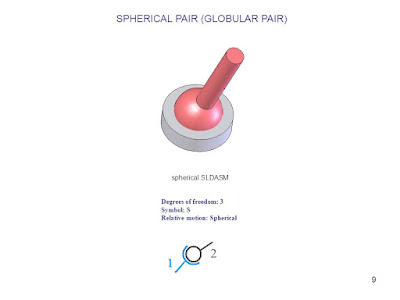Lecture - 3 (Kinematics pairs)
KINEMATIC PAIRS
any connection between two links is always known as joint or a pair but this pair will only be a kinematic pair when the relative motion between the links is a constrained motion.
Classification of kinematic pairs
1. According to the type of relative motion
any connection between two links is always known as joint or a pair but this pair will only be a kinematic pair when the relative motion between the links is a constrained motion.
Classification of kinematic pairs
1. According to the type of relative motion
- TURNING PAIR - relative motion between two links is pure turning forms a turning pair. these pairs are also called revolute pair or pin joint pair
- SLIDING PAIR - Relative motion between two links is pure sliding forms a sliding pair. These pairs are also called as prizmatic pair.
- ROLLING PAIR - Relative motion between two links is pure rolling forms a rolling pair. Pure rolling means rolling without slipping.
In
below figure of a ball bearing, inner race ( link 1 ) and ball ( link 2
) forms a rolling pair. Similarly ball ( link 2 ) and outer race (
link 3 ) forms a rolling pair. But inner race ( link 1 ) and outer race (
link 3 ) of bearing forms a turning pair
- SCREW PAIR - relative motion over the threads forms a screw pair. Example is Nut and bolt
- SPHERICAL PAIR - when relative motion between two links is 3-dimensional rotation than it forms a spherical pair. For example, spherical pair is used in side mirror of cars & bikes for adjustment.
- LOWER PAIR - when there is surface contact between two links then its called lower pair.
- HIGHER PAIR - when there is a point or line contact between two links then its called as higher pair
3. According to type of closure
- SELF CLOSED PAIR OR CLOSED PAIR - the permanent contact between 2 links forms a self closed pair. Examples are turning pair, rolling pair, sliding pair.
- FORCED CLOSED PAIR OR OPEN PAIR - the forceful contact between 2 links forms a forced closed pair. Examples are higher pair in cam & follower, door closer, automatic clutch operation system










in case of cam and follower example how cam and fixed link forms a lower pair?
ReplyDeleteCam and fixed link is connected with a turning pair, which is cylindrical pin and the surface of this cylindrical pin is in contact. Whenever there is surface contact lower pair is formed.
DeleteVery interesting, Wish to see much more like this. Thanks for sharing your information!
ReplyDelete